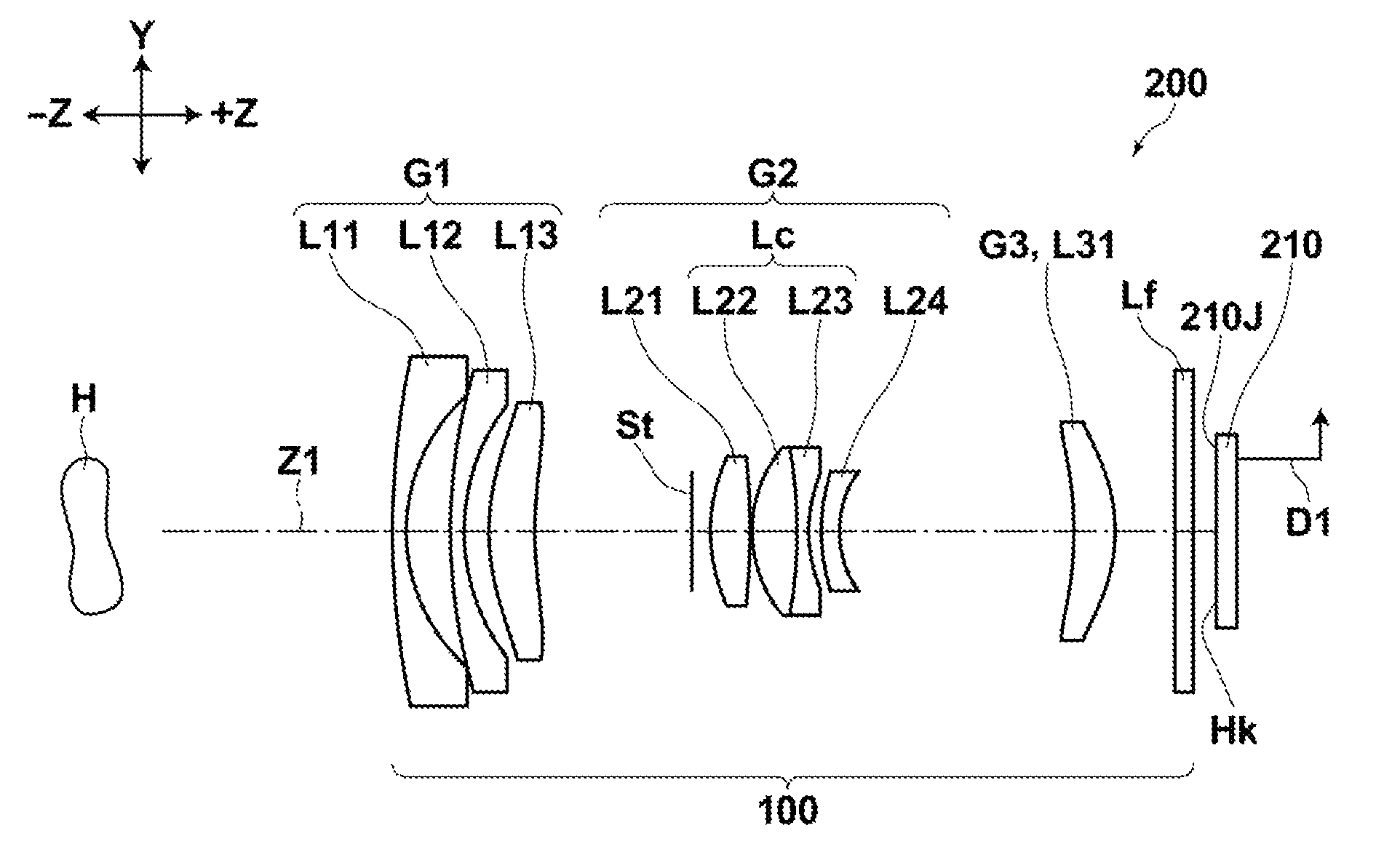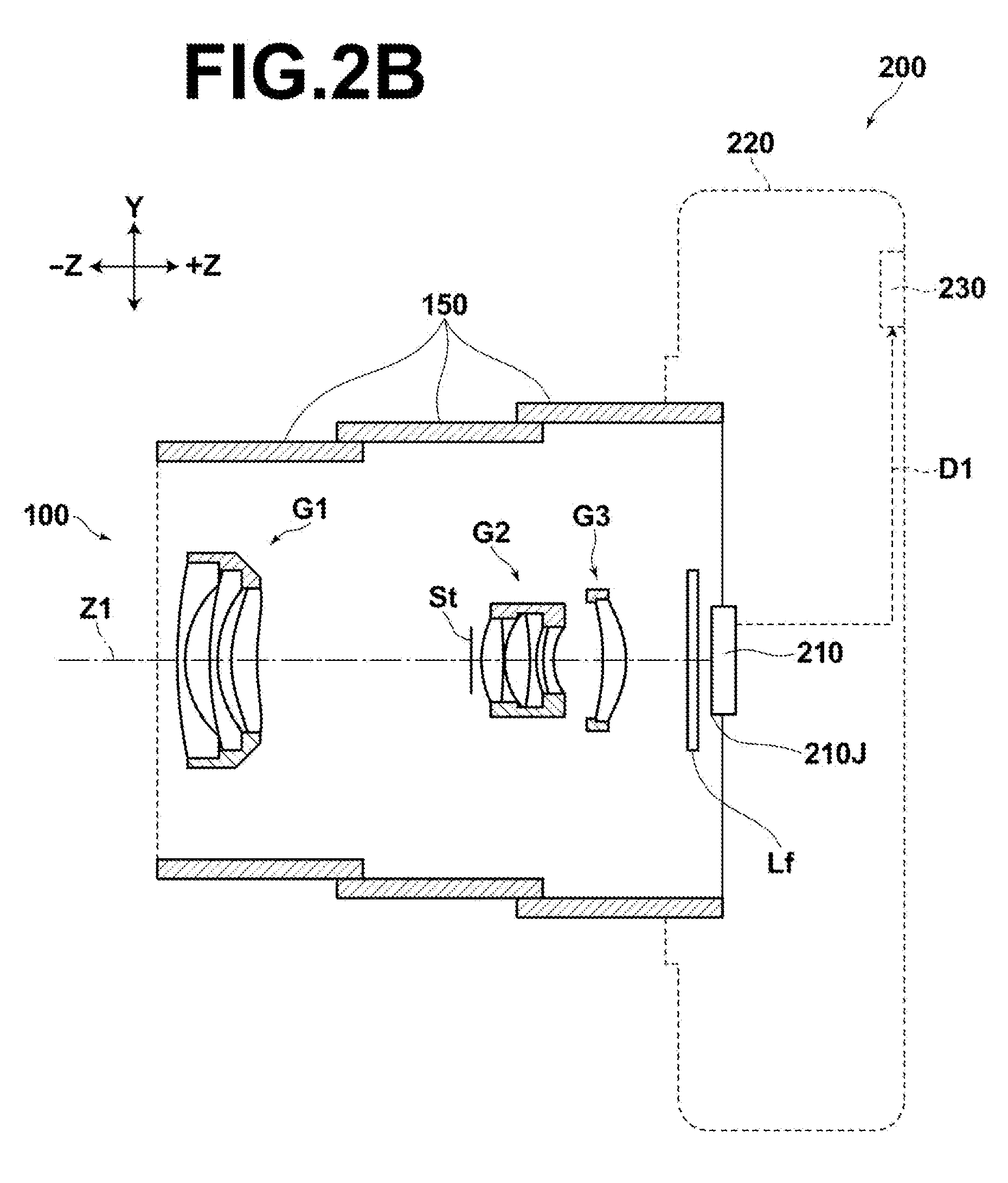[0008]The present invention has been developed in view of the circumstances described above, and it is an object of the present invention to provide a three-group zoom lens which is compact, yet capable of preventing aberrations over the entire zoom range.
[0027]According to the zoom lens of the present invention, a first lens group having a negative power, a second lens group having a positive power, and a third lens group having a positive power are arranged in this order from an object side and an aperture stop which is moved integrally with the second lens group is provided, and zooming is performed by changing a distance between the first and second lens groups and a distance between the second and third lens groups. Here, the first lens group is composed of a first group first lens having a negative power with a concave surface facing an image side, a first group second lens having a negative power with a concave surface facing the image side, and a first group third lens having a positive power and at least one aspheric surface with a convex surface facing the object side arranged in this order from the object side, the second lens group is composed of a second group first lens having a positive power with a convex surface facing the object side, a cemented lens having a positive power as a whole, and a second group fourth lens having a negative power and at least one aspheric surface with a concave surface facing the image side arranged in this order from the object side, in which the cemented lens is composed of a second group second lens having a positive power with a convex surface facing the object side and a second group third lens having a negative power with a concave surface facing the image side arranged in this order from the object side, and the third lens group is composed of a third group first lens having a positive power. This allows downsizing of the zoom lens while preventing aberrations over the entire zoom range.
[0028]That is, as the lens on the most image side in the second group is a negative lens, the positive lenses on the object side in the second lens group may be formed to have a strong refractive power. This allows effective diameters of the lenses in the second lens group to be reduced so that the outer diameter of the entire second lens group may be reduced. Further, as the lens on the most image side in the second lens group has at least one aspheric surface, aberrations may be prevented more reliably over the entire zoom range.
[0029]Further, if the zoom lens of the present invention is constructed so as to be retracted inside of an image pickup apparatus by moving the second lens group of the zoom lens in a direction orthogonal to the optical axis and moving the entire zoom lens in an optical direction, the thickness of the zoom lens, when retracted, in the optical axis direction may be reduced.
[0030]That is, for example, more and more recent digital cameras employ a retraction method, when retracting a zoom lens inside of an image pickup apparatus, in which the entire zoom lens is retracted inside of the image pickup apparatus by shifting a particular lens group in a direction perpendicular to the optical axis and moving each lens group in the optical axis direction. In that case, each lens group is moved in the optical axis direction and retracted such that the lens group shifted in a direction orthogonal to the optical axis and other lens groups are not overlapped in the optical axis direction. Here, it is demanded that the thickness of the entire zoom lens in the optical axis direction, when it is retracted, be reduced and the outer diameter of the lens barrel, when the entire zoom lens is retracted inside of the image pickup apparatus, be reduced by reducing the outer diameter of the lens group to be shifted in a direction orthogonal to the optical axis.
[0031]According to the structure of the zoom lens of the present invention described above, the use of a negative lens as the lens disposed on the most image side in the second lens group allows the outer diameter of the second lens group which is smaller than the other lens groups (first and third lens groups) due to being positioned near the aperture stop to be further reduced. Thus, if an arrangement is adopted in which the entire zoom lens is retracted by moving the second lens group in a direction orthogonal to the optical axis and moving the entire zoom lens in the optical axis direction, the thickness of the entire zoom lens in the optical axis direction and the outer diameter thereof, when it is retracted, may be reduced, as described above. Therefore, the space required to retract the entire zoom lens inside of the image pickup apparatus may be reduced.
 Login to view more
Login to view more  Login to view more
Login to view more 


